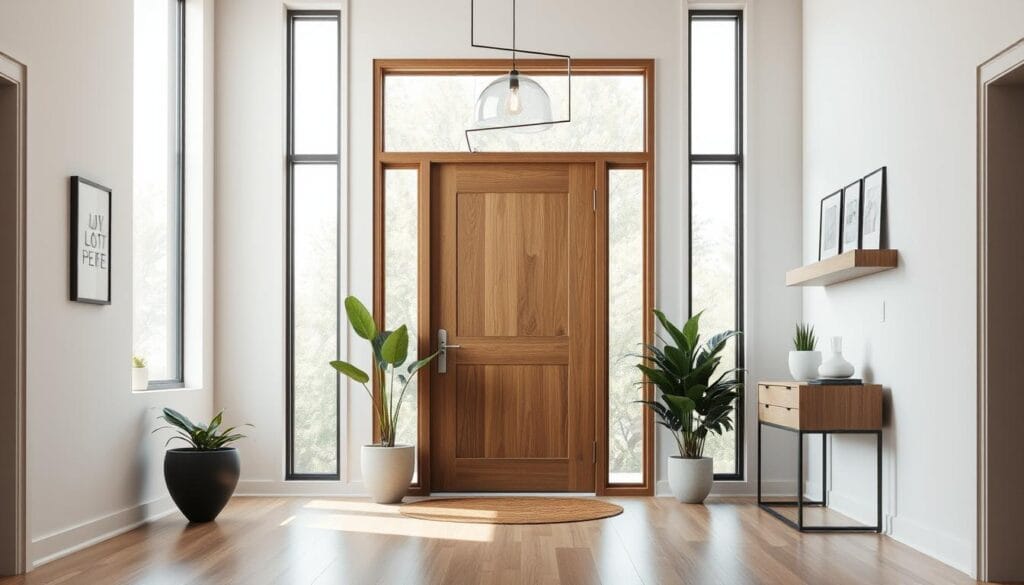Ever walked into your home and felt overwhelmed by the chaos at the entryway? Shoes scattered, coats piled up, and keys mysteriously missing? We’ve all been there. But what if your entry could be a calm, organized space that sets the tone for the rest of your day?
Transforming a mudroom into a functional drop zone doesn’t have to be complicated. With a little creativity and smart design, you can turn this often-overlooked area into a practical work of art. Built-in benches, open cubbies, and clever storage solutions can make a world of difference for busy families.
Imagine stepping into a space where everything has its place. No more frantic searches for essentials. Just a welcoming, clutter-free zone that makes life a little easier. Ready to get started? Let’s explore how simple changes can bring big results.
Understanding Your Mudroom and Drop Zone Needs
Does your entryway feel like a catch-all for chaos? Shoes, coats, and bags pile up, making it hard to find what you need. But with a little planning, you can turn this space into a functional and organized area that works for your family.
Why Organization is Key
Proper organization is fundamental to a successful drop zone. Without it, clutter quickly takes over. Studies show that homes with dedicated drop zones report a 25% decrease in time spent cleaning. That’s because everything has its place, making it easier to maintain order.
Think about your daily routine. Where do you put your keys, bags, or mail? A well-organized space ensures these items are always within reach. It’s not just about tidiness—it’s about creating a system that saves time and reduces stress.
Defining Functional Areas
To make the most of your mudroom, start by identifying your specific needs. Does your family require space for backpacks, shoes, or pet gear? Dividing the area into dedicated zones helps everyone know where items belong.
Here’s a simple breakdown of functional areas to consider:
| Zone | Purpose | Example Items |
|---|---|---|
| Entry | Keys, mail, phones | Key hooks, mail organizer |
| Storage | Coats, bags, shoes | Cubbies, baskets, hooks |
| Pet Area | Leashes, toys, towels | Pet shower, storage bin |
By defining these zones, you’ll maximize your space and keep clutter at bay. For more ideas on optimizing small areas, check out our guide on maximizing space with functional solutions.
Remember, a focused approach to organization can transform your mudroom into a welcoming and efficient space. Start small, and you’ll see big results in no time!
The Perfect Drop Zone: Creating a Clutter-Free Mudroom
Ever wondered how to make your entryway both stylish and practical? It’s easier than you think! With the right features, you can turn this high-traffic area into a functional space that works for your family.
Essential Features for an Effective Entryway
An organized entryway starts with smart design. Built-in cabinetry and custom storage solutions can make a huge difference. These features help keep clutter at bay while adding a touch of style.
Designated drop areas for coats, shoes, and accessories are a must. They ensure everything has its place, making it easier to maintain order. Open shelving paired with closed cabinets offers a balance of accessibility and tidiness.
Here’s a quick guide to essential features:
| Feature | Purpose | Example |
|---|---|---|
| Built-in Cabinets | Hidden storage | Closed cabinets for shoes |
| Open Shelving | Easy access | Shelves for bags and hats |
| Designated Drop Zones | Daily essentials | Hooks for keys and coats |
By integrating these features, you’ll create a seamless, clutter-free space right at your door. Start small, and you’ll see big results in no time!
Assess Your Entryway Layout
Your entryway’s layout plays a crucial role in keeping clutter under control. Before diving into design changes, take a moment to evaluate how the space is currently used. This step ensures you make the most of every inch while addressing problem areas.
Identifying Available Space
Start by measuring the dimensions of your entryway. Look for underutilized areas, like empty wall sections or corners. These spots can be transformed into functional storage zones with the right solutions.
Consider these tips for maximizing space:
- Use vertical space with hooks or shelves.
- Add a bench with hidden storage for shoes or bags.
- Repurpose awkward corners with custom shelving.
Spotting Potential Clutter Zones
Clutter often accumulates in specific areas. Identify these hotspots by observing where items tend to pile up. Common zones include near the door, under benches, or on open surfaces.
Here’s how to tackle them:
- Install hooks or racks for coats and bags.
- Use baskets or bins to corral smaller items.
- Designate a spot for keys, mail, and daily essentials.
By assessing your entryway layout, you’ll create a clear roadmap for a more organized and functional space. Turn challenges into opportunities for creative storage solutions!
Designing Your Ideal Mudroom Layout
Designing a mudroom layout that works for your home starts with smart planning. Think about how you use the space daily. What items need storage? Where do they belong? Answering these questions ensures your layout is both functional and stylish.
Start by mapping out your space. Measure the area and note any unique features like corners or alcoves. This helps you maximize every inch. Consider how many people will use the space and what they’ll need to store.

Next, focus on storage solutions. Cabinets and shelves are essential for keeping clutter at bay. Choose designs that match your home’s style while providing ample space for everyday items. Open shelving works great for quick access, while closed cabinets hide messes.
Here’s a quick guide to planning your layout:
| Feature | Purpose | Example |
|---|---|---|
| Cabinets | Hidden storage | Closed cabinets for shoes |
| Shelves | Easy access | Open shelves for bags |
| Bench | Seating and storage | Bench with cubbies |
Finally, think about materials and finishes. Durable options like tile flooring and premium composite boards are ideal for high-traffic areas. Add finishing touches like hooks or baskets to complete the look. With careful planning, your mudroom will be both beautiful and practical.
Implementing Smart Storage Solutions
Looking for ways to keep your entryway tidy and stylish? Smart storage solutions can make all the difference. By combining functionality with design, you can create a space that’s both practical and inviting.
Choosing the Right Cabinets and Baskets
Cabinets and baskets are essential for maintaining order. Closed cabinets hide clutter, while open baskets offer easy access to everyday items. Wicker baskets, for example, add a touch of warmth and texture to your space.
When selecting cabinets, consider your family’s needs. Do you need space for shoes, bags, or seasonal items? Opt for designs that blend seamlessly with your home’s aesthetic. Baskets, on the other hand, are perfect for corralling smaller items like keys or scarves.
Incorporating Open Shelving Options
Open shelving is a game-changer for frequently used items. It keeps essentials within reach while adding visual interest to your entryway. Use shelves for bags, hats, or even decorative accents to personalize the space.
Pair open shelving with closed storage for a balanced look. This mix ensures everything has its place, reducing clutter immediately. Here’s a quick guide to help you decide:
| Storage Type | Best For | Example |
|---|---|---|
| Cabinets | Hidden storage | Closed cabinets for shoes |
| Baskets | Quick access | Wicker baskets for keys |
| Open Shelving | Frequently used items | Shelves for bags and hats |
By implementing these smart storage solutions, you’ll transform your entryway into a functional and stylish space. Start small, and you’ll see big results in no time!
Utilizing Vertical Space for Enhanced Storage
Maximizing vertical space is a game-changer for small entryways. By thinking upward, you can create extra storage without sacrificing floor space. Wall-mounted cubbies and tall storage units are your best friends here.
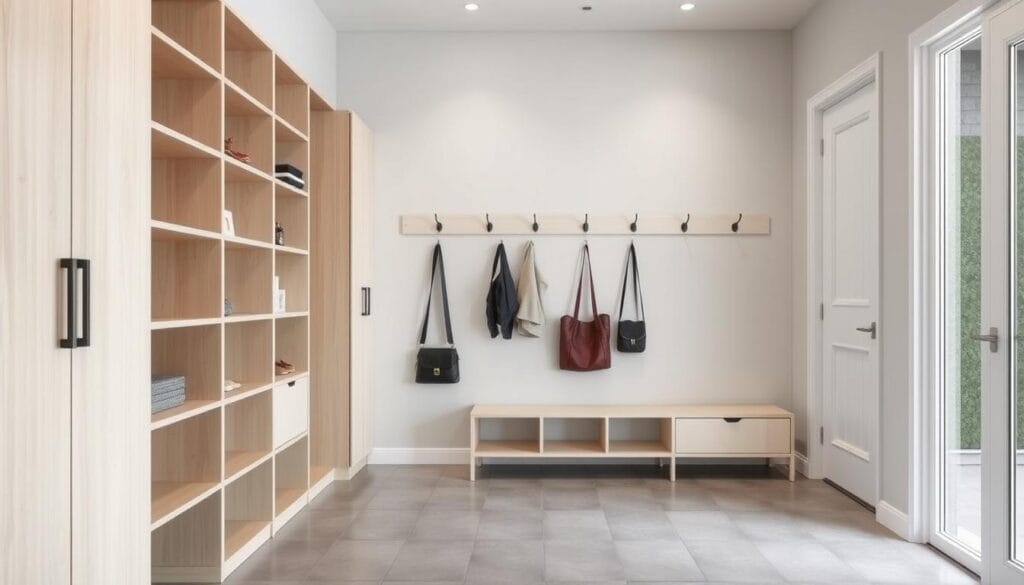
Why focus on vertical solutions? They make every inch of your wall functional. Items like coats, bags, and shoes stay organized and accessible. Plus, they free up valuable floor area for other uses.
Here are some practical tips to get started:
- Install wall-mounted cubbies for quick access to everyday items.
- Use tall cabinets to store seasonal gear or less frequently used items.
- Add hooks or racks for coats and bags to keep them off the floor.
Vertical storage isn’t just practical—it’s stylish too. Open shelving can display decorative accents while keeping essentials within reach. Closed cabinets hide clutter, maintaining a clean look.
Here’s a quick guide to vertical storage solutions:
| Solution | Purpose | Example |
|---|---|---|
| Wall-Mounted Cubbies | Quick access | Cubbies for keys and mail |
| Tall Cabinets | Hidden storage | Cabinet for shoes and bags |
| Hooks and Racks | Daily essentials | Hooks for coats and hats |
By using vertical space, you’ll transform your entryway from cluttered to curated. Start small, and you’ll see big results in no time!
Creating a Multi-Functional Seating Area
Need a spot to sit and store essentials? A built-in bench is your answer. It’s the perfect blend of comfort and practicality, offering a place to sit while keeping your entryway organized. Whether you’re putting on shoes or setting down a bag, a bench with storage makes life easier.
Why choose a bench with hidden compartments? It’s a smart way to store shoes and coats without cluttering your space. Integrated storage beneath the seat keeps everything neatly tucked away. This dual-purpose design is ideal for busy households.
Here’s how to make the most of your bench:
- Opt for durable materials like vinyl or porcelain tiles for longevity.
- Choose finishes that match your home’s style for a cohesive look.
- Add cushions for extra comfort and a touch of personality.
A well-designed bench doesn’t just look good—it keeps your entryway orderly. By providing a dedicated spot for shoes and coats, it reduces clutter and makes daily routines smoother. Plus, it’s a welcoming feature for guests.
Thinking about adding one? Start by measuring your space to ensure a perfect fit. Then, explore designs that suit your needs. With a multi-functional bench, you’ll transform your entryway into a practical and stylish zone.
Incorporating Hooks, Baskets, and Cubbies
Want to keep your entryway tidy without sacrificing style? Simple organizers like hooks, baskets, and cubbies can make a big difference. These tools help you create a functional space where everything has its place.
Tips for Hanging Coats and Bags
Start with sturdy hooks for coats and bags. Choose hardware that can handle daily use without damaging your walls. Mount them at different heights to accommodate both adults and kids.
Pair hooks with labeled baskets for accessories like scarves and gloves. This keeps items accessible while maintaining order. For more ideas on maximizing space, check out our guide on space-saving solutions.
Organizing Shoes and Accessories
Use bins or cubbies to store shoes and smaller items. Assign a specific spot for each family member to avoid mix-ups. Labels or color-coded bins can help everyone know where things belong.
Here’s a quick guide to organizing with baskets and cubbies:
- Place a bin by the door for frequently used shoes.
- Use cubbies for backpacks, hats, and other essentials.
- Add a small basket for keys and mail to keep them in one spot.
By incorporating these simple solutions, you’ll create an entryway that’s both functional and stylish. Start small, and you’ll see big results in no time!
DIY Mudroom Build Essentials and Tools
Ready to tackle your mudroom project with confidence? With the right tools and materials, you can create a functional and stylish space that works for your family. Let’s break down what you’ll need to get started.
Key Tools and Materials for Success
Every successful DIY project starts with the right gear. A miter saw is a must for precise cuts, while a brad nailer ensures seamless assembly. Don’t forget a laser level—it’s the best option for keeping everything straight and professional-looking.
Quality materials are just as important as tools. Opt for durable items like melamine boards or plywood for cabinets and shelves. These choices not only look great but also stand up to daily wear and tear.
Here’s a quick checklist of essentials:
- Miter saw for accurate cuts
- Brad nailer for secure assembly
- Laser level for straight installations
- Melamine boards or plywood for durability
Investing in the right gear makes the build smoother and safer. Plus, it ensures your mudroom will last for years to come. Whether you’re a seasoned DIYer or just starting out, these tools and materials set you up for success.
By choosing the right option for each step, you’ll match your design vision with effective results. Ready to roll up your sleeves and get started? Your dream mudroom is just a few steps away!
Personalizing Storage for Each Family Member
Transform your mudroom into a space that works for everyone in your family. By tailoring storage solutions, you can create a functional and welcoming entryway that meets individual needs. Let’s explore how to make this happen.
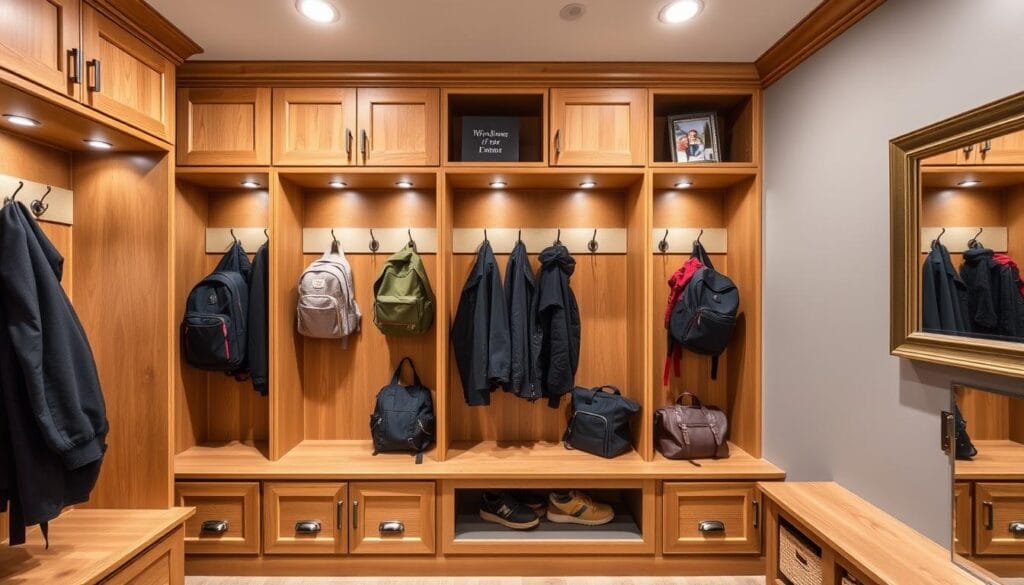
Effective Labeling Strategies
Labels are a simple yet powerful way to keep your mudroom organized. Assigning a specific spot for each family member ensures everyone knows where their items belong. Use color-coded baskets or bins to make it even easier.
For younger kids, consider adding picture labels alongside text. This helps them identify their space without confusion. Expert advice suggests using durable materials for labels to withstand daily wear and tear.
Custom Storage Solutions
Custom-built storage units can cater to the unique needs of your household. Think about what each family member uses daily—backpacks, shoes, or sports gear—and design storage around those items.
Open cubbies work great for quick access, while closed cabinets hide clutter. Add hooks at different heights to accommodate both adults and kids. This thoughtful approach ensures your mudroom is both practical and stylish.
By personalizing your storage, you’ll create a space that reflects your family’s lifestyle. Start small, and you’ll see big results in no time!
Maintaining an Organized Entryway
Keeping your entryway organized doesn’t have to be a daily struggle. With a few simple habits and routines, you can ensure this high-traffic area stays clutter-free and welcoming. Let’s explore how to make organization a seamless part of your day.
Daily Habits for a Clutter-Free Space
Start by establishing small, consistent habits. Encourage everyone in the family to put items like shoes, coats, and bags in their designated spots as soon as they walk through the door. This prevents clutter from piling up and keeps the space tidy.
Visual cues like labels or color-coded bins can reinforce these habits. For example, assign a specific basket for each family member’s shoes or backpacks. This makes it easy to look and know exactly where things belong.
Here’s a quick checklist for daily habits:
- Put shoes in their designated spot immediately.
- Hang coats and bags on assigned hooks.
- Place keys and mail in a central basket or tray.
Regular Cleaning Routines
In addition to daily habits, a weekly cleaning routine helps maintain a pristine entryway. Set aside 10-15 minutes to dust shelves, wipe down surfaces, and vacuum the floor. This prevents dirt and dust from accumulating over time.
Don’t forget to declutter regularly. Go through baskets, cubbies, and storage areas to remove items that no longer belong. This ensures your space stays functional and organized.
Here’s a simple weekly cleaning checklist:
| Task | Frequency | Tips |
|---|---|---|
| Dust shelves and surfaces | Weekly | Use a microfiber cloth for best results. |
| Vacuum or sweep the floor | Weekly | Focus on corners and under furniture. |
| Declutter storage areas | Monthly | Remove items that are no longer needed. |
By incorporating these habits and routines, you’ll create an entryway that’s both functional and inviting. Small efforts add up to big results, making your door area a calm and organized space for everyone.
Enhancing Functionality with Built-In Furniture
Looking to maximize your mudroom’s potential? Built-in furniture is the answer. These solutions not only save space but also add a polished touch to your entryway. From storage benches to wall-mounted units, built-in options keep your space organized and stylish.
One of the biggest advantages is stability. Integrated posts and supports ensure your furniture stays secure, even with daily use. This makes built-ins a practical choice for busy households. Plus, they’re customizable to fit your exact needs.
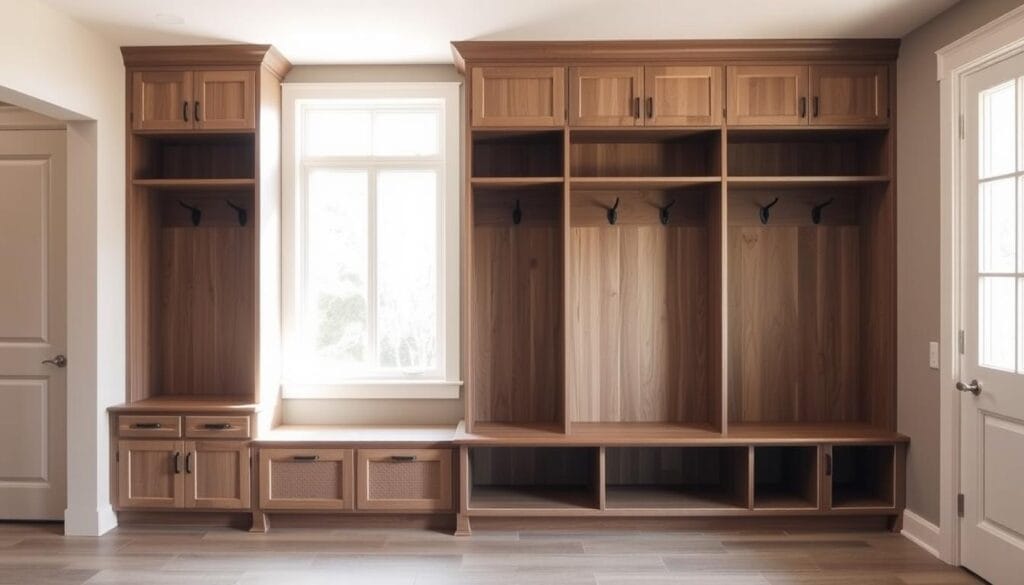
Small design touches can make a big difference. For example, adding a slide-out tray for shoes or hooks for coats keeps everything within sight and reach. These details enhance functionality while maintaining a clean look.
Built-in furniture also keeps your drop zone efficient and chic. By blending storage with seating, you create a multi-functional space that works hard for your family. It’s a smart way to make the most of every inch.
Here are some practical tips for installing built-in furniture:
| Tip | Purpose | Example |
|---|---|---|
| Level Everything | Ensures stability | Use a laser level for accuracy |
| Secure Posts | Prevents wobbling | Anchor posts to wall studs |
| Match Aesthetics | Blends with decor | Choose finishes that complement your home |
By incorporating built-in furniture, you’ll create a mudroom that’s both functional and beautiful. It’s a lasting solution that keeps your space organized and welcoming. Start small, and you’ll see big results in no time!
Inspiring Mudroom Design Ideas from Experts
Ready to explore creative mudroom designs that blend practicality with personality? We’ve gathered ideas from top designers to help you transform your entryway into a space that’s both functional and stylish. Whether you’re working with a small corner or a dedicated room, these expert tips will spark your imagination.
Family-Friendly and Stylish Innovations
Designing a mudroom that works for your family doesn’t mean sacrificing style. Experts suggest using durable materials like tile flooring and melamine boards to withstand daily wear and tear. Open cubbies and closed cabinets keep essentials organized while maintaining a clean look.
For families with kids, consider adding lower hooks for jackets and backpacks. This encourages independence and keeps clutter off the floor. A built-in bench with hidden storage is another smart idea that combines seating with practicality.
Adding Decorative Touches
Decorative elements can elevate your mudroom from functional to fabulous. Start with a color scheme that complements your home’s aesthetic. Add texture with wicker baskets or woven rugs for a cozy feel.
Don’t overlook small details like stylish hat hooks or a wall-mounted mirror. These touches not only enhance the look but also improve functionality. For more ideas, check out these modern mudroom design ideas that blend form and function seamlessly.
| Design Element | Purpose | Example |
|---|---|---|
| Color Scheme | Enhances aesthetics | Soft neutrals or bold accents |
| Hooks and Racks | Organizes daily essentials | Stylish jacket hooks |
| Decorative Accents | Adds personality | Trendy hat hooks or artwork |
By incorporating these ideas, you’ll create a mudroom that’s both inviting and efficient. Start small, and you’ll see big results in no time!
Transforming Small Entryways into Smart Drop Zones
Small entryways can feel cramped, but with smart design, they become efficient drop zones. By reworking these spaces, you can turn even the tiniest house entry into a functional and stylish area. Let’s explore how to make the most of every inch.
Start by assessing your place. Measure the area and identify underutilized spots like corners or walls. Vertical storage solutions, such as wall-mounted hooks or shelves, can free up floor space while keeping essentials within reach. This approach maximizes functionality without overwhelming the area.
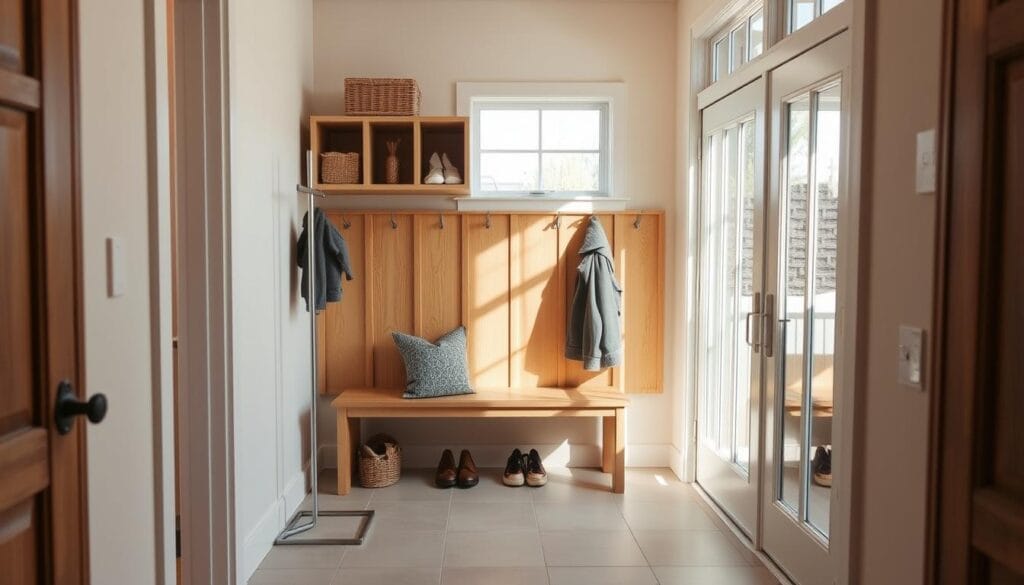
Compact accessories are key to organizing small spaces. Choose slim benches with hidden storage or narrow baskets for shoes and backpacks. These items fit seamlessly into tight areas while maintaining a clean look. Built-in cubbies or floating shelves can also add storage without taking up valuable floor space.
Here are some practical tips for transforming your entryway:
- Use vertical space with hooks or shelves for coats and bags.
- Opt for multi-functional furniture like benches with storage compartments.
- Add labeled baskets or bins to keep smaller items organized.
Smart planning ensures your entryway works hard for your family. By selecting storage that fits your house layout, you’ll create a place that’s both practical and inviting. Small changes can make a big impact, turning clutter into calm.
Don’t forget to personalize your space. Add decorative touches like a stylish rug or a wall-mounted mirror to enhance the look. These details not only improve aesthetics but also make the area feel more welcoming. With thoughtful design, even the smallest entryway can become a smart drop zone.
Troubleshooting Common Mudroom Organization Challenges
Struggling to keep your mudroom organized despite your best efforts? You’re not alone. Even the most well-planned spaces can face challenges like limited space or overload. Let’s dive into practical solutions to keep your entryway functional and clutter-free.
Overcoming Limited Space Issues
Small mudrooms can feel overwhelming, but with smart adjustments, you can maximize every inch. Start by using vertical space. Wall-mounted hooks or shelves are great for coats, bags, and accessories. This frees up floor space and keeps essentials within reach.
Another tip is to add multi-functional furniture. A bench with hidden storage doubles as seating and a place to stash shoes or seasonal items. Compact solutions like narrow baskets or slim cabinets also work wonders in tight areas.
Here’s a quick guide to optimizing small spaces:
- Use vertical storage for coats and bags.
- Choose furniture with built-in storage.
- Label bins or baskets to keep items organized.
Simple Fixes for Overload
When your mudroom feels overloaded, it’s time to reassess. Start by decluttering regularly. Remove items that don’t belong and assign a specific spot for everything. This ensures your space stays functional and welcoming.
Encourage every family member to take responsibility for their items. Assign labeled bins or hooks for each person. This reduces mix-ups and keeps the area tidy. For added efficiency, add a central basket for keys and mail.
Here’s a quick troubleshooting table for common issues:
| Issue | Solution | Example |
|---|---|---|
| Cluttered Floors | Use hooks or shelves | Wall-mounted hooks for coats |
| Overloaded Storage | Declutter regularly | Monthly clean-out of bins |
| Family Mix-Ups | Assign personal spaces | Labeled bins for each member |
By addressing these challenges, you’ll create a mudroom that works for your family. Small changes can make a big difference, turning chaos into calm. Start today and enjoy a more organized entryway!
Conclusion
Imagine stepping into a space where everything feels calm and in its place. With thoughtful planning and smart design, you can transform your home’s entrance into a functional and welcoming area. From built-in storage to vertical solutions, each element plays a role in keeping clutter at bay.
By defining zones and personalizing storage, you’ll ensure everything has its place. Small changes, like hooks or labeled bins, make a big difference. These adjustments not only improve organization but also reduce daily stress.
Now’s the time to put these ideas into action. Start small, and enjoy the process of creating a space that works for your family. Your dream entryway is just a few steps away!


